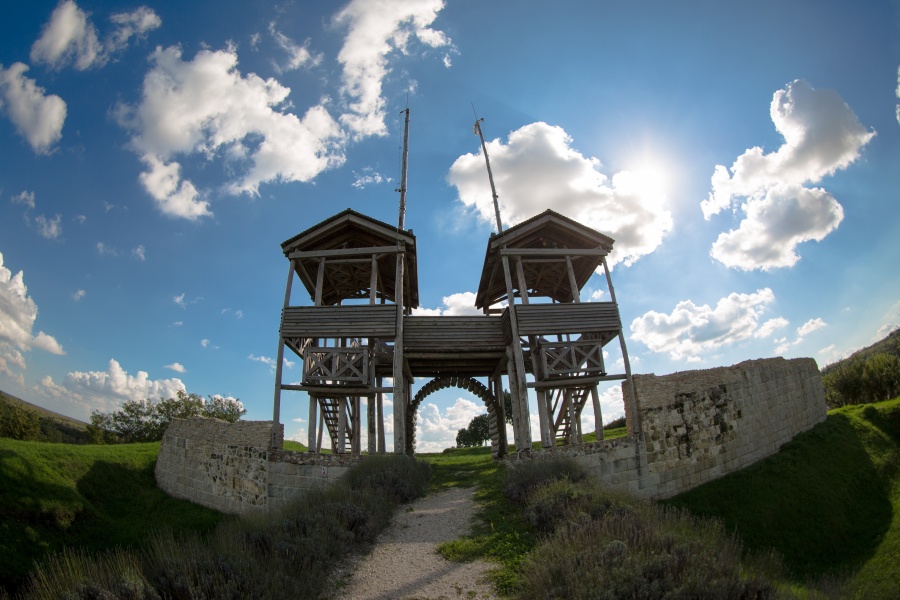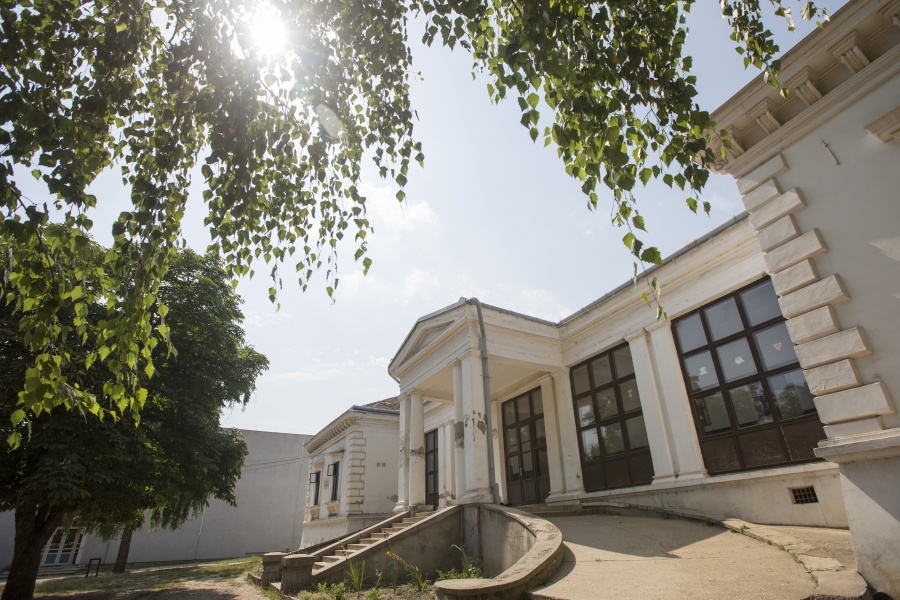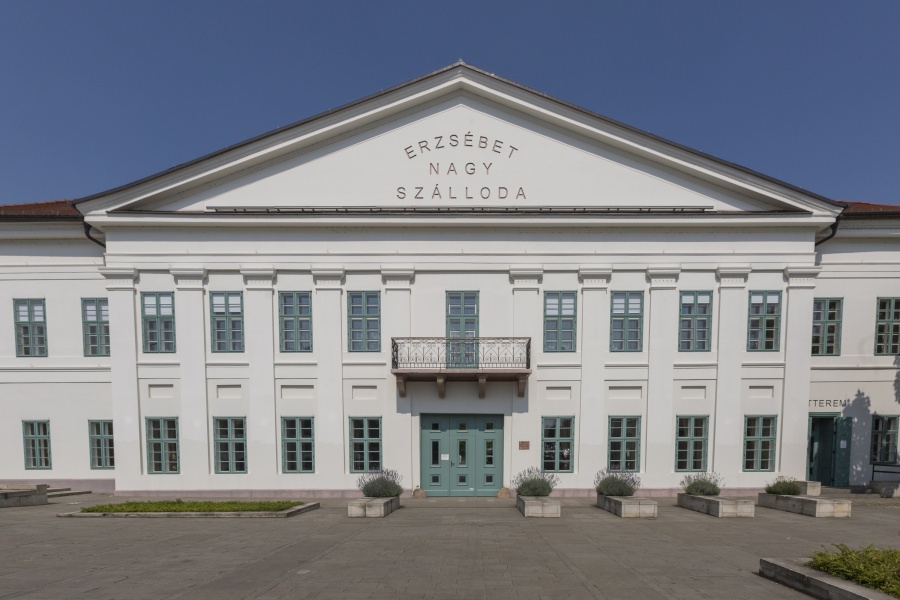History of Paks
Danube: past, present and future of the town
Age of the Roman Empire
Among the Danube, which was part of the border of the former province, there was a special reinforced military line called the limes, built by roman conquerors in the end of the 1st century-beginning of the 2th century. This military line consisted of fortresses and watchtowers. The castrum (military base), which was built in Bottyán hill of Dunakömlőd was part of this line, called Lussonium. According to the structure of borderline there could be several watchtowers in the area of Paks.
The crew of the watchtowers consisted of lussonium cohors soldiers, which meant a foot soldier unit around 500-1000 people. Beside the military base there was an upcountry settlement, a civilian settlement (vicus) in the area of Dunakömlőd, which belonged to the base. Also discovered in the area of Paks and Dunakömlőd smaller, partially self-sufficient villa economies and partially romanizated villages of the local population.
The archeological exploration of the military base of Dunakömlőd is still in progress for almost 20 years. During these explorations many military and civil building were explored. The analyzation of artifacts and objects which were explored during excavations allude to the existence of the first fort of the auxiliary regiments during the reign of emperor Claudius (41-54 AD), which means it was built in the middle of the 1st century AD, and was used in the 2nd century AD. It was also helpful to engross the extension and rampart system of the late roman fortress. During excavations the northern fortification system of the fortress, defensive ditches, two southern gate towers and several, 1,3 m wide walls of the fortress were explored. In the inside of the building’s southern wall there was a barrack room, which had an entry underpinned with wooden pillars (porticus).

In the late roman age (end of the 4th century AD), when the fortress was no longer used, they built a little fortress a few meters to the north from the southern gate tower. This was a 10 x 9 m tower, which was used after the surrender of the province, in the beginning of the migration period. The appearance of huns was the end of the roman reign in Pannonia: in 433 AD, the Roman Empire officially handed over the province to the hun king, Attila.
Middle Ages
After the reign of huns, from 433 AD until 455 AD, the reign of the Longobard kingdom had started in Transdanubia. Their reign was elimaneted in 568 AD by the Pannonian Avars, who arrived from the east. Their presence trailed for several centuries, until the Hungarian conquest of the Carpathian Basin by hungarians of Árpád and the establishment of the Kingdom of Hungary. After the foundation, the first written records about the area of Paks belonged to Madocsa, a village in Tolna county.
The name of Paks first appeared in written form in 1333, in a papal tithe column, which claimed that Lőrinc priest of Paks paid 23 banovac. At almost the same time (in 1354) Olivér house of Rathold (Rátót), origin from Italy, was mentioned, who was a Judge royal, than the Master of the treasury. Louis I. (also Louis the Great) gave him a royal property in the land of Paks and his progenies had already used consistently the surname Paksy. Descendants of the family appeared in many positions during the 14th-16th century and they played a significant part in the era: László Paksy was a Count of the Székelys and a Master of the treasury under the reign of Matthias Corvinus, he was also the patronage of constructions of Franciscans in Paks, according to this, the building of Franciscan monasteries in the Middle Age attached also to the House of Paksy. János Paksy was a Chamberlain, then a Royal treasurer, he died in the battlefield of Mohács. The last male member of the House, László Paksy died in 1992 ,without a male descendant: the fortune of the House was inherited by Anna Paksy, her husband Zsigmond Daróczy of Királydarócz and their progenies. Later in history. The Daróczy family and the Száraz family are mentioned as inheritors of Paks property.
Modern history
Under the rule of Ottoman Empire, Paks was crossed by the main routes of campaigns, hereby it became the buffer territory of empires fighting against each other. Ottomans who occupied the land, were building a blocked palisade from the rocks of destroyed buildings of Paks and Kalocsa, also they proceeded other constructions. In Paks’ cemetery, the tomb of Árkods baba became a famous musulman pilgrimage site under the rule of Ottoman Empire. The castle then and the town that time, is only known because of the documentations of Evliya Çelebi, an ottoman explorer and Heinrich Ottendorf, an austrian engineer colonel and also, thanks to a line drawing made by Ottendorf. After the Austro-Turkish War (1663-1664) and the wars of liberation, there was not remained any building from the era of the Ottoman Empire. The probe excavation, which was executed in 1995, in the Church hill of Paks, proved that, a civilian settlement existed in this territory under the rule of Ottoman Empire.
After the liberating wars, during the reorganization of the county, Paks had a significant role again: between 1698 and 1703 it was the location of seven general meeting of counties and István Daróczy, the local imperial postmaster got a vicecomes title.
The town had market rights since 1730, beside the dominancy of agriculture, the guilds gathered more and more ground: however, we do not know the exact time of the first guild’s establishement, they were operating in the second half of the 18th cetury for sure. These guilds provided manufactured goods for people in the area.
In parallel, the trade was also upswinging by the regulation of the Danube, near Imsós forest in 1841, when the main stream of the river got at close quarters to the town. Protecting/flow direction changing breakwaters needed to be built, but the regulation also enabled the operation of ship mills. The fleet of ship mills and the operation of miller guild had an important role in the development of trade. At the same time, the port of Paks was established, where the first stream ship (called Pest) was docked in 1846.
From the 18th-19th century, commoner families of Paks played important roles in the history of the town. For example: the Kornis, Szeniczey, Szluha, (baron) Rudnyánszky, Kiss from Nemeskér, Rosty from Barkóc, Csuzy and the Vigyázó families. The former mainsons of Cseh-Vigyázó, Daróczy, Kornis, Kurcz and Szeniczey define the image of the downtown until today.

The famous relative, Ferenc Deák, "The Wise Man of the Nation" was a frequent guest in the Szeniczey mainson from the 1850’s, who gladly passed his time in Paks and often visited for example the Casino (established in 1842), which was the third casino in the country after Pest and Pozsony. In 1844 the classicist Erzsébet Grand Hotel was built, which provided a place for the Art Gallery of Paks for a while. From 1847 the town kept the memory of Zsigmond Daróczy, who supported social reforms.

At the time of Hungarian Revolution of 1848, Paks provided many soldiers and officers to the National Guard of Tolna County. The army of Count Josip Jelačić von Bužim went through the town in 30th of April, 1849. In 1849, after the Surrender, among other people Pál Jámbor, poet of Paks, forced to emigrate.
In the era of Autocracy, which followed the Hungarian Revolution of 1848-1849, in spite of political opportunities were narrowing down, there was a slow economic and cultural development, which was speeded up after the Austro-Hungarian Compromise of 1867. In 1873-1874 guilds were dissolved one after the other, instead of them industry associations were established. Schools, cultural associations started to operate, the health care system improved, the Firefighters Association was established, a local printing office was founded in 1873, and the first newspaper of Paks was published entitled as Transport-Care in 1880. The Paks territory savings co-op office and the Trade Corporation of Paks were established, the baroque Bazaar Line was built in 1876, the religious life was upswinging. These actions all point to the increase and improvement of merchant and trade.
The establishment of Archeological and Historical Association of Tolna County (established by Sándor Novák, doctor and an amateur archeologist), the opening of observatory (equipped by Géza Szeniczey), the establishment of Civil Boys’ School in 1893 and the Szelle Museum (equipped by the collection and books of Zsigmond Szelle, a sheriff-depute and also an amateur archeologist) allude to the development of culture and education. Unfortunately, the Szelle Museum was completely destroyed during the World War II. In 1901 a new parish church was built, mainly by public subscription and also the construction of the catholic girls’ school was completed.
The 20th century
It is symbolical that, in the year of the Millennium in 1896, the first shuttle train arrived to the train station of Paks. In parallel, another increasingly development had started in the town. In 1906 the public switched telephone network was built, the direct current electric pile started to operate in 1911, these refered to the urbanisation and technological development. Another proof of the economic development was the establishment of Krausz-Moskovits United Trade Corporation (fruit dryer-distillery), which is the predecessor of the Packing House, also the opening of the Stream Brickyard after the Great Depression, near the Sánc Hill and the updating of electricity network.
The economical boost in the first half of the 20th century was arresting by a government decision on the construction of the Danube bridge in 1926. The bridge was not built in Paks, but in Dunaföldvár and according to this decision the configuration of Paks-Tolna-Mözs-Szekszárd railway line was also deleted. In parallel, the ship mills of the Danube were progressively replaced by stream mills.
Mainly the operation of the Packing House and the Stream Brickyard marked the trade of Paks that time, but of course agriculture and another industries were also under expansion. The glory days for the Stream Brickyard’s operation were during the constructions in Dunaújváros (formerly known as Dunapentele and Sztálinváros).
The construction of the four reactor blocks of the Nuclear Power Plant between 1973 and 1987 had been livening up the economical and social development of Paks. A whole new part of the town was built for the arriving people, with concrete streets, a modern residential area and new services (school, kindergarten, clinic, post office, etc.). The Church of the Holy Spirit, which was sanctified in 1990, designed by Imre Makovecz and the grey and green blocks of the Nuclear Power Plant, which represent the functionalist architecture, are also part of the image of the richest non agglomerational town of our country, as an attraction.

Source: Lívia Gábor: Paksravaló – Utazás az ország középpontja felé (Guidebook of Paks, 2012)

